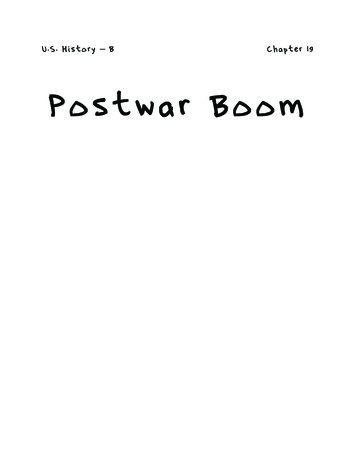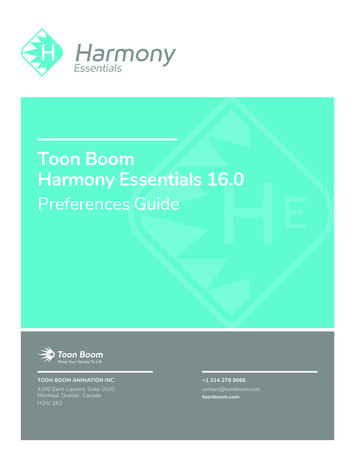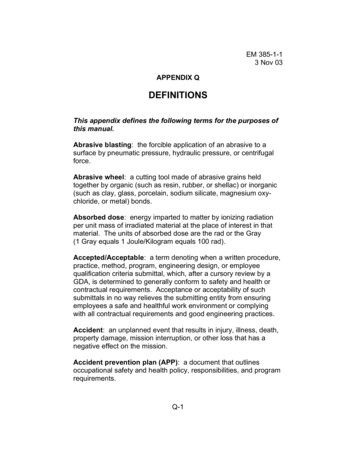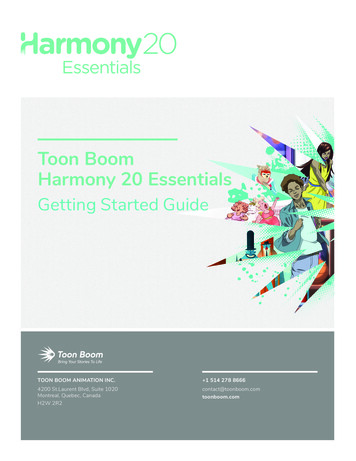
Transcription
U.S. History – BChapter 19Postwar Boom
632-633-Chapter 1910/21/025:42 PMPage 632Page 1 of 2In the 1950s, the backyard was the perfectplace for suburban homeowners to relax.1946 Baby boombegins.1947JackieRobinsonintegratesmajor leaguebaseball.1948Harry S.Trumanis electedpresident.1950’s Discjockey AlanFreed is thefirst to usethe term“rock ‘n’ roll”on the air.USAWORLD1949 Mao Zedong'sCommunist forces gaincontrol of China.632CHAPTER 191950 Korean Warbegins.1952 DwightD. Eisenhoweris electedpresident.
632-633-Chapter 1910/21/025:42 PMPage 633Page 2 of 2INTERACTWI T HHI S T O RYYou have returned home from servingin World War II to find that your country is changing. The cities have swelled.Outlying suburbs are being built upwith almost identical homes. Americaproduces more and cheaper goods. In abooming economy, couples marry andstart families in record numbers. Asyou watch clever ads on TV for thenewest labor-saving gadgets, you feelnostalgia for a simpler time.What is theAmerican dreamof the 1950s?Examine the Issues How does pressure to conformaffect the American dream? Who might be excluded from thenew prosperity? How does advertising promotecertain lifestyles and ideals?RESEARCH LINKSCLASSZONE.COMVisit the Chapter 19 links for more informationabout The Postwar Boom.1953 KoreanWar cease-fireis signed.1954 USSRopens the firstsmall nuclearpower plant.1954Brown v. Board ofEducation ofTopeka outlawsschool segregation.1956Eisenhoweris reelected.1956 Sovietscrush uprisingin Hungary.1958 NASA—the National Aeronautics and SpaceAdministration—is established.1957 Sovietslaunch Sputnik I.1959 Alaskaand Hawaiibecome the49th and 50thstates.1960 JohnF. Kennedyis electedpresident.1959 FidelCastrocomes topower inCuba.The Postwar Boom633
634-640-Chapter 1910/21/025:43 PMPage 634Page 1 of 7Postwar AmericaMAIN IDEAThe Truman and Eisenhoweradministrations led the nationto make social, economic,and political adjustmentsfollowing World War II.WHY IT MATTERS NOWIn the years after World War II,the United States became theeconomic and military power thatit still is today.Terms & Names GI Bill of Rights suburb Harry S. Truman Dixiecrat Fair DealOne American's StorySam Gordon had been married less than ayear when he was shipped overseas in July1943. As a sergeant in the United StatesArmy, he fought in Belgium and Franceduring World War II. Arriving back homein November 1945, Sam nervously anticipated a reunion with his family. A friend,Donald Katz, described Sam’s reactions.A PERSONAL VOICE DONALD KATZ“ Sam bulled through the crowd andhailed a taxi. The cab motored norththrough the warm autumn day as hegroped for feelings appropriate to beingback home alive from a terrible war. . . .[He was] nearly panting under the weightof fear. . . . Back home alive . . . marriedto a girl I haven’t seen since 1943 . . .father of a child I’ve never seen at all.”— Home FiresReadjustment and RecoveryBy the summer of 1946, about 10 million men and women had been releasedfrom the armed forces. Veterans like Sam Gordon—along with the rest ofAmerican society—settled down to rebuild their lives.634CHAPTER 19 Sam Gordon met his daughter, Susan,for the first time the day he returned homefrom the war, and he went to work the next morning. Like many other youngcouples, the Gordons began to put the nightmare of the war behind them and toreturn to normality.GIs returned hometo their familiesafter World War IIwith new hope,but also with newproblems.
634-640-Chapter 1910/21/025:43 PMPage 635Page 2 of 7THE IMPACT OF THE GI BILL To help easeveterans’ return to civilian life, Congress passedthe Servicemen’s Readjustment Act, or theGI Bill of Rights, in 1944. In addition toencouraging veterans to get an education bypaying part of their tuition, the GI Bill guaranteed them a year’s worth of unemploymentbenefits while job hunting. It also offered lowinterest, federally guaranteed loans. Millions ofyoung families used these benefits to buyhomes and farms or to establish businesses. HOUSING CRISIS In 1945 and 1946, returning veterans faced a severe housing shortage.Many families lived in cramped apartments ormoved in with relatives. In response to thishousing crisis, developers like William Levittand Henry Kaiser used efficient, assembly-linemethods to mass-produce houses. Levitt, whobragged that his company could build a housein 16 minutes, offered homes in small residential communities surrounding cities, called suburbs, for less than 7,000.Levitt’s first postwar development—rows of standardized homes built on treeless lots—was located on New York’s Long Island and named Levittown. Thesehomes looked exactly alike, and certain zoning laws ensured that they would staythe same. Despite their rigid conformity, Americans loved the openess and smalltown feel to the planned suburbs. With the help of the GI Bill, many veteransand their families moved in and cultivated a new lifestyle.The suburbswere a massphenomenon, evenon moving day.REDEFINING THE FAMILY Tension created by changes in men’s and women’sroles after the war contributed to a rising divorce rate. Traditionally, men were thebreadwinners and heads of households, while women were expected to stay homeand care for the family. During the war, however, about 8 million women, 75 percent of whom were married, entered the paid work force. These women supported their families and made important household decisions. Many were reluctantto give up their newfound independence when their husbands returned. By 1950,more than a million war marriages had ended in divorce.BackgroundSee unemploymentrate on page R47in the EconomicsHandbook.MAIN IDEAIdentifyingProblemsA Whatproblems didAmericans faceafter World War II?ECONOMIC READJUSTMENT After World War II, the United States convertedfrom a wartime to a peacetime economy. The U.S. government immediately canceled war contracts totaling 35 billion. Within ten days of Japan’s surrender,more than a million defense workers were laid off. Unemployment increased asveterans joined laid-off defense workers in the search for jobs. At the peak of postwar unemployment, in March 1946, nearly 3 million people were seeking work.Rising unemployment was not the nation’s only postwar economic problem,however. During the war, the Office of Price Administration (OPA) had haltedinflation by imposing maximum prices on goods. When these controls ended onJune 30, 1946, prices skyrocketed. In the next two weeks, the cost of consumerproducts soared 25 percent, double the increase of the previous three years. Insome cities, consumers stood in long lines, hoping to buy scarce items, such assugar, coffee, and beans. Prices continued to rise for the next two years until thesupply of goods caught up with the demand.While prices spiraled upward, many American workers also earned less thanthey had earned during the war. To halt runaway inflation and to help the nationconvert to a peacetime economy, Congress eventually reestablished controls similar to the wartime controls on prices, wages, and rents. AA. AnswerHousing shortages, employment, readjustment to familylife, rising inflation andlower wages,and shortagesof goods.The Postwar Boom635
Millions ofHomeowners634-640-Chapter 1910/21/025:43 PMPage 636REMARKABLE RECOVERY Most economists who had forecast a postwardepression were proved wrong because they had failed to consider consumers’pent-up accumulation of needs and wants. People had gone without many goodsfor so long that by the late 1940s, with more than 135 billion in savings fromdefense work, service pay, and investments in war bonds, Americans suddenlyhad money to spend. They snatched up everything from automobiles to houses.After a brief period of postwar economic readjustment, the American economyboomed. The demand for goods and services outstripped the supply and increasedproduction, which created new jobs. Judging from thegraphs (shown left), many Americans prospered in theA Dynamic Economy1950s in what the economist John Kenneth Galbraithcalled “the affluent society.”Home OwnershipThe Cold War also contributed to economic growth.35Concern over Soviet expansion kept American defense30spending high and people employed. Foreign-aid programs, such as the Marshall Plan, provided another boost25to the American economy. By helping nations in WesternEurope recover from the war, the United States helped201950 1952 1954 1956 1958 1960itself by creating strong foreign markets for its exports. BAutomobile RegistrationsMillions ofRegistrations706050401950 1952 1954 1956 1958 1960Income in DollarsMedian Family Income60005000400030001950 1952 1954 1956 1958 1960Billions of DollarsSavings Accounts25201510501950 1952 1954 1956 1958 1960 1962Source: Historical Statistics of the United States, Colonial timesto 1970SKILLBUILDERInterpreting Graphs1. From 1950 to 1960, by what percentage did each of the economicindicators shown above increase?2. Which years show the biggestincreases for each of the graphsabove?636Page 3 of 7CHAPTER 19Meeting Economic ChallengesDespite an impressive recovery, Americans faced a number of economic problems. Their lives had been in turmoil throughout the war, and a desire for stability madethe country more conservative.PRESIDENT TRUMAN’S INHERITANCE When HarryS. Truman suddenly became president after Franklin D.Roosevelt’s death in 1945, he asked Roosevelt’s widow,Eleanor, whether there was anything he could do for her.She replied, “Is there anything we can do for you? Foryou are the one in trouble now.” In many ways, PresidentTruman was in trouble.A PERSONAL VOICE HARRY S. TRUMAN“ I don’t know whether you fellows ever had a loadof hay fall on you, but when they told me yesterdaywhat had happened [Roosevelt’s death], I felt likethe moon, the stars, and all the planets had fallenon me.”—excerpt from a speech, April 13, 1945Despite his lack of preparation for the job, Trumanwas widely viewed as honorable, down-to-earth, andself-confident. Most important of all, he had the abilityto make difficult decisions and to accept full responsibility for their consequences. As the plaque on hisWhite House desk read, “The Buck Stops Here.”Truman faced two huge challenges: dealing with therising threat of communism, as discussed in Chapter18, and restoring the American economy to a strongfooting after the war’s end.MAIN IDEAAnalyzingCausesB What factorscontributed to theAmerican postwareconomic boom?B. Answer TheGI bill, whichoffered veteranslow-interestloans and education benefits;wage, price, andrent controls;the Cold War,military build-up,and foreign aidprograms, suchas the MarshallPlan; savings,and a desirefor consumerproducts.SkillbuilderAnswers1. Home ownership—38%;Automobile registrations—50%;Income—75%;Savings—400%2. Home 1952–1954;Median ��1962.
634-640-Chapter 1910/21/02MAIN IDEASummarizingC What actionsdid PresidentTruman take toavert laborstrikes?C. AnswerTruman threatened to draftstriking workers,keep them onthe job as soldiers and to takecontrol of therailroads andmines.5:43 PMPage 637Page 4 of 7TRUMAN FACES STRIKES One economic problem that Truman had to addresswas strikes. Facing higher prices and lower wages, 4.5 million discontented workers, including steelworkers, coal miners, and railroad workers, went on strike in1946. Although he generally supported organized labor, Truman refused to letstrikes cripple the nation. He threatened to draft the striking workers and to orderthem as soldiers to stay on the job. He authorized the federal government to seizethe mines, and he threatened to take control of the railroads as well. Trumanappeared before Congress and asked for the authority to draft the striking railroadworkers into the army. Before he could finish his speech, the unions gave in. C“HAD ENOUGH?” Disgusted by shortages of goods, risinginflation, and labor strikes, Americans were ready for achange. The Republicans asked the public, “Had enough?”Voters gave their answer at the polls: in the 1946 congressional elections, the Republican Party won control of boththe Senate and the House of Representatives for the firsttime since 1928. The new 80th Congress ignored Truman’sdomestic proposals. In 1947, Congress passed the TaftHartley Act over Truman’s veto. This bill overturned manyrights won by the unions under the New Deal.Social Unrest PersistsProblems arose not only in the economy but in the veryfabric of society. After World War II, a wave of racialviolence erupted in the South. Many African Americans,particularly those who had served in the armed forces during the war, demanded their rights as citizens.In 1947, Jackie Robinson joined theBrooklyn Dodgers, angering somefans but winning the hearts, andrespect, of many others. Vocabularydiscrimination:treatment basedon class orcategory ratherthan individualmeritTRUMAN SUPPORTS CIVIL RIGHTS Truman put his presidency on the line for civil rights. “I am asking for equalityof opportunity for all human beings,” he said, “. . . and ifthat ends up in my failure to be reelected, that failure willbe in a good cause.” In September 1946, Truman met withAfrican-American leaders who proposed a federal antilynching law, abolition of the poll tax as a voting requirement, and the establishment of a permanent body to prevent racial discrimination in hiring.Congress refused to pass these measures, or a measure to integrate the armedforces. As a result, Truman himself tookaction. In July 1948, he issued an executive order for integration of the armedforces, calling for “equality of treatmentand opportunity in the armed forces without regard to race, color, religion, or national origin.” In addition, he ordered an endto discrimination in the hiring of government employees. The Supreme Court alsoruled that the lower courts could not barHISTORICALS P O TLIG H TJACKIE ROBINSONJackie Robinson took a brave stepwhen he turned the BrooklynDodgers into an integrated baseball team in 1947. But he—andthe country—had a long way to go.Unhappy fans hurled insults atRobinson from the stands. Someplayers on opposing teams triedto hit him with pitches or to injurehim with the spikes on theirshoes. He even received deaththreats. But he endured this withpoise and restraint, saying,“Plenty of times, I wanted tohaul off when somebodyinsulted me for the color ofmy skin but I had to hold tomyself. I knew I was kind ofan experiment.”In 1949, Robinson was votedthe National League’s most valuable player. He later became thefirst African American to beinducted into the Baseball Hall of
634-640-Chapter 1910/21/025:43 PMPage 638Page 5 of 7African Americans from residential neighborhoods.These actions represented the beginnings of a federalcommitment to dealing with racial issues. DTHE 1948 ELECTION Although many Americansblamed Truman for the nation’s inflation and laborunrest, the Democrats nominated him for presidentin 1948. To protest Truman’s emphasis on civil rights,a number of Southern Democrats—who becameknown as Dixiecrats—formed the States’ RightsDemocratic Party, and nominated their own presidential candidate, Governor J. Strom Thurmond ofSouth Carolina. Discontent reigned at the far left ofthe Democratic spectrum as well. The former vicepresident Henry A. Wallace led his supporters outof mainstream Democratic ranks to form a moreliberal Progressive Party.As the election approached, opinion polls gave the Republican candidate,New York Governor Thomas E. Dewey, a comfortable lead. Refusing to believe thepolls, Truman poured his energy into the campaign. First, he called theRepublican-dominated Congress into a special session. He challenged it to passlaws supporting such elements of the Democratic Party platform as public housing, federal aid to education, a higher minimum wage, and extended SocialSecurity coverage. Not one of these laws was passed. Then he took his campaignto the people. He traveled from one end of the country to the other by train,speaking from the rear platform in a sweeping “whistlestop campaign.” Day after day, people heard the president denounce the“do-nothing, 80th Congress.” Wipe OutDiscrimination(1949), a posterby Milton Ackoff,depicts thecivil rightsconsciousnessthat angered theDixiecrats.MAIN IDEASummarizingD How didTruman use hisexecutive powerto advance civilrights?D. AnswerTruman issuedan executiveorder integratingthe military afterCongressrefused to act.SkillbuilderAnswers1. Truman—theWest, theMidwest, andthe South;Dewey—theNorthwest, theNortheast, andthe Midwest;Thurmond—theSouth.2. The Northeastand the South.STUNNING UPSET Truman’s “Give ’em hell, Harry” campaignworked. He won the election in a close political upset. TheDemocrats gained control of Congress as well, even thoughthey suffered losses in the South, which had been solidlyDemocratic since Reconstruction.386432544434411810423* Tennessee—11 electoral votes for Truman,1 electoral vote for Thurmond1947352528 138 1111151412*89129 111081066125416481638Truman surprised thenewspapers by winningthe 1948 election.Party Presidential Election of arry S. Truman30324,179,000RepublicanThomas E. Dewey18921,991,000States’ RightsJ. Strom Thurmond391,176,000ProgressiveHenry A. Wallace—1,157,000GEOGRAPHY SKILLBUILDER1. Region In which regions of the country did Trumancarry states? Dewey? Thurmond?2. Region In which regions was support for Truman theweakest?638CHAPTER 19
634-640-Chapter 1910/21/02MAIN IDEAEvaluatingLeadershipE What weresome of Truman’sachievements aspresident?E. Answer Heled the U.S. tofinal victory inWorld War II,dealt with labordisputes, andsupported socialprograms andcivil rights legislation.Page 639Page 6 of 7THE FAIR DEAL After his victory, Truman continued proposing an ambitiouseconomic program. Truman’s Fair Deal, an extension of Roosevelt’s New Deal,included proposals for a nationwide system of compulsory health insurance anda crop-subsidy system to provide a steady income for farmers. In Congress,some Northern Democrats joined Dixiecrats and Republicans in defeating bothmeasures.In other instances, however, Truman’s ideas prevailed. Congress raised thehourly minimum wage from 40 cents to 75 cents, extended Social Security coverage to about 10 million more people, and initiated flood control and irrigationprojects. Congress also provided financial support for cities to clear out slums andbuild 810,000 housing units for low-income families. ERepublicans Take the Middle RoadDespite these social and economic victories, Truman’sapproval rating sank to an all-time low of 23 percent in1951. The stalemate in the Korean War and the risingtide of McCarthyism, which cast doubt on the loyalty ofsome federal employees, became overwhelming issues.Truman decided not to run for reelection. The Democratsnominated the intellectual and articulate governor AdlaiStevenson of Illinois to run against the Republican candidate, General Dwight D. Eisenhower, known popularlyas “Ike.”I LIKE IKE! During the campaign, the Republicansaccused the Democrats of “plunder at home and blunderabroad.” To fan the anti-Communisthysteria that was sweeping over thecountry, Republicans raised the specterof the rise of communism in China andEastern Europe. They also criticized thegrowing power of the federal government and the alleged bribery and corruption among Truman’s political allies.Eisenhower’s campaign hit a snag, however, when newspapers accused his runningmate, California Senator Richard M. Nixon, ofprofiting from a secret slush fund set up bywealthy supporters. Nixon decided to reply tothe charges. In an emotional speech to anaudience of 58 million, now known as the“Checkers speech,” he exhibited masterfuluse of a new medium—television. Nixondenied any wrongdoing, but he did admit toaccepting one gift from a political supporter. Vocabularyslush fund: a fundoften designatedfor corruptpractices, suchas bribery5:43 PMCampaignaccessoriesexpressed Ike’spopularity andvoters’ desire fora positive politicalchange.A PERSONAL VOICE RICHARD M. NIXON“ You know what it was? It was a little cocker spaniel dog in a crate, that he’d[the political supporter] sent all the way from Texas. Black and white spotted.And our little girl—Tricia, the six-year-old—named it Checkers. And you know thekids, like all kids, love the dog and I just want to say this right now, that regardless of what they say about it, we’re going to keep it.”—“Checkers speech,” September 23, 1952The Postwar Boom639
634-640-Chapter 1910/21/025:43 PMPage 640Page 7 of 7Nixon’s speech saved his place on theRepublican ticket. In November 1952,Eisenhower won 55 percent of the popularvote and a majority of the electoral collegevotes, while the Republicans narrowly captured Congress. Countering slushfund charges,Richard Nixonspeaks to TVviewers about hisdaughters andtheir dog,Checkers.WALKING THE MIDDLE OF THE ROADPresident Eisenhower’s style of governingdiffered from that of the Democrats. Hisapproach, which he called “dynamic conservatism,” was also known as “ModernRepublicanism.” He called for governmentto be “conservative when it comes tomoney and liberal when it comes tohuman beings.”Eisenhower followed a middle-of-theroad course and avoided many controversial issues, but he could not completely sidestep a persistent domestic issue—civilrights—that gained national attention due to court rulings and acts of civildisobedience in the mid-1950s. The most significant judicial action occurred in1954, when the Supreme Court ruled in Brown v. Board of Education of Topeka thatpublic schools must be racially integrated. (See page 708.) In a landmark act of civildisobedience a year later, a black seamstress named Rosa Parks refused to give up herseat on a bus to a white man. Her arrest sparked a boycott of the entire Montgomery,Alabama, bus system. The civil rights movement had entered a new era.Although Eisenhower did not assume leadership on civil rights issues, heaccomplished much on the domestic scene. Shortly after becoming president,Eisenhower pressed hard for programs that would bring around a balanced budget and a cut in taxes. During his two terms, Ike’s administration raised the minimum wage, extended Social Security and unemployment benefits, increasedfunding for public housing, and backed the creation of interstate highways andthe Department of Health, Education, and Welfare. His popularity soared, and hewon reelection in 1956.1. TERMS & NAMES For each term or name, write a sentence explaining its significance. GI Bill of Rights suburb Harry S. Truman DixiecratMAIN IDEACRITICAL THINKING2. TAKING NOTESCreate a time line of key eventsrelating to postwar America. Use thedates below as a guide.3. DRAWING CONCLUSIONSDo you think Eisenhower’s actionsreflected his philosophy of dynamicconservatism? Why or why not?Think About: the definition of dynamicconservatism Eisenhower’s actions on civilrights policies Eisenhower’s accomplishmentson other domestic issues1946 1947 1948 19491952Write a paragraph describing theeffects of one of these events.640CHAPTER 19 Fair Deal4. EVALUATING LEADERSHIPWhy do you think most Americanswent along with Eisenhower'sconservative approach to domesticpolicy?5. CONTRASTINGHow did Presidents Truman andEisenhower differ regarding civilrights?
10/21/025:43 PMPage 641Page 1 of 9The American Dreamin the FiftiesMAIN IDEADuring the 1950s, theeconomy boomed, and manyAmericans enjoyed materialcomfort.Terms & NamesWHY IT MATTERS NOWThe “American dream,” a notionthat was largely shaped by the1950s, is still pursued today. conglomerate franchise baby boom Dr. Jonas Salk consumerism plannedobsolescenceOne American's StorySettled into her brand new house near San Diego, California,Carol Freeman felt very fortunate. Her husband Mark had hisown law practice, and when their first baby was born, shebecame a full-time homemaker. She was living the Americandream, yet Carol felt dissatisfied—as if there were “somethingwrong” with her because she was not happy.A PERSONAL VOICE CAROL FREEMAN“ As dissatisfied as I was, and as restless, I remember so wellthis feeling [we] had at the time that the world was going tobe your oyster. You were going to make money, your kids weregoing to go to good schools, everything was possible if you justdid what you were supposed to do. The future was rosy. Therewas a tremendous feeling of optimism. . . . Much as I say itwas hateful, it was also hopeful. It was an innocent time.”—quoted in The Fifties: A Women’s Oral History 641-649-Chapter 19After World War II ended, Americans turned their attention to their familiesand jobs. The economy prospered. New technologies and business ideas createdfresh opportunities for many, and by the end of the decade Americans wereenjoying the highest standard of living in the world. The American dream of ahappy and successful life seemed within the reach of many people.The Organization and the Organization ManThe dreamwoman of the1950s wasdepicted inadvertising andon TV as doingconstanthousework, butalways witha smile.During the 1950s, businesses expanded rapidly. By 1956, the majority ofAmericans no longer held blue-collar, or industrial, jobs. Instead, more peopleworked in higher-paid, white-collar positions—clerical, managerial, or professional occupations. Unlike blue-collar workers, who manufactured goods for sale,white-collar workers tended to perform services in fields like sales, advertising,insurance, and communications.The Postwar Boom641
641-649-Chapter 1910/21/025:43 PMPage 642Page 2 of 9CONGLOMERATES Many white-collar workers performed their services in largecorporations or government agencies. Some of these corporations continuedexpanding by forming conglomerates. (A conglomerate is a major corporationthat includes a number of smaller companies in unrelated industries.) For example, one conglomerate, International Telephone andTelegraph (ITT), whose original business was communications, bought car-rental companies, insurance companies,and hotel and motel chains. Through this diversification,or investment in various areas of the economy, ITT triedto protect itself from declines in individual industries.FRANCHISESOther huge parent companies included AmericanIn the decades since Ray KrocTelephone and Telegraph, Xerox, and General Electric.opened his first McDonald’sTHENN OW(shown below), franchising hasbecome all but a way of life inthe United States. Today, thereare nearly 3,000 franchisedcompanies operating over500,000 businesses throughoutthe country. Officials estimatethat franchises account for nearlyone-third of all U.S. retail sales.American franchises today provide a wide array of goods andservices, from car maintenance,to tax services, to hair care.In an attempt to tap into theinternational market, hundreds ofU.S. companies have establishedoverseas franchises. The franchise with perhaps the greatestglobal reach is the one that started it all. In addition to its morethan 10,000 U.S. franchises,McDonald’s now operates over14,000 franchises in dozens ofcountries around the world.FRANCHISES In addition to diversifying, another strategy for business expansion—franchising—developed atthis time. A franchise is a company that offers similarproducts or services in many locations. (Franchise is alsoused to refer to the right, sold to an individual, to do business using the parent company’s name and the systemthat the parent company developed.) AFast-food restaurants developed some of the first andmost successful franchises. McDonald’s, for example, hadits start when the McDonald brothers developed unusually efficient service, based on assembly-line methods, attheir small drive-in restaurant in San Bernardino,California. They simplified the menu, featured 15-centhamburgers, and mechanized their kitchen.Salesman Ray Kroc paid the McDonalds 2.7 millionfor the franchise rights to their hamburger drive-in. InApril 1955, he opened his first McDonald’s in DesPlaines, Illinois, where he further improved the assembly-line process and introduced the golden arches thatare now familiar all over the world.A PERSONAL VOICE RAY KROC“ It requires a certain kind ofmind to see the beauty in a hamburger bun. Yet is it any moreunusual to find grace in the texture and softly curved silhouetteof a bun than to reflect lovinglyon the . . . arrangements andtextures and colors in a butterfly’s wings? . . . Not if you viewthe bun as an essential materialin the art of serving a greatmany meals fast.”—quoted in The FiftiesSOCIAL CONFORMITY While franchises like McDonald’s helped standardizewhat people ate, some American workers found themselves becoming standardized as well. Employees who were well paid and held secure jobs in thriving companies sometimes paid a price for economic advancement: a loss of their individuality. In general, businesses did not want creative thinkers, rebels, or anyonewho would rock the corporate boat.642CHAPTER 19MAIN IDEAComparingA How wereconglomeratesand franchisesalike and howwere theydifferent?A. Answer Bothwere successfulbusiness entities that grewrapidly. The conglomerate grewby diversifying;franchises grewby opening identical stores innew locations.
MAIN IDEAAnalyzingEffectsB What effectsdid the climate inmany corporationshave on someworkers?B. AnswerSome becamedissatisfied withthe emphasis onconformity andthe impersonalcorporateatmosphere.SkillbuilderAnswer1. The birthrateremained almostthe same fromthe beginning ofthe war until thewar ended. Thenit increased.2. It droppedfrom 24 per 1000to 19 per 1000.5:43 PMPage 643Page 3 of 9In The Organization Man, a book based on a classic 1956 study of suburban Park Forest, Illinois, and other communities, William H. Whytedescribed how the new, large organizations created “company people.”Companies would give personality tests to people applying for jobs tomake sure they would “fit in” the corporate culture. Companiesrewarded employees for teamwork, cooperat
1949 Korean War begins. 1950 632 CHAPTER 19 USA WORLD In the 1950s, the backyard was the perfect place for suburban homeowners to relax. Harry S. Truman is elected 1948 Disc jockey Alan Freed is the first to use the term "rock 'n' roll" on the air. 1950's 632-633-Chapter 19 10/21/02 5:42 PM Page 632











